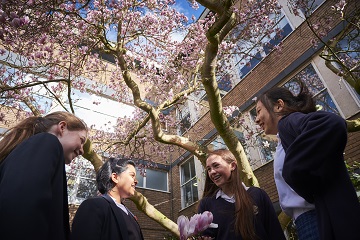Located at the heart of our Senior School site is a Cortile (courtyard), which houses a beautiful Magnolia tree.
Formerly part of the Cambridge University Botanic Garden, the Magnolia tree provided a welcoming site for visitors to the Gardens using the original public entrance on Bateman Street. This entrance ran between the garden of The Elms and Paston House, separating St Mary's school. This caused great inconvenience: the school dinner cooked in the Convent kitchen had to be propelled on a trolley down Bateman Street to Paston House front door!
The School had long been in negotiation with the University to buy this intervening area, or build a bridge over it or even make a tunnel under it. In October 1952, we agreed to exchange part of our original school gardens with the Botanic Garden, in return for this area of land between The Elms and Paston House.
This agreement enabled David Wyn Roberts - an architect known for designing many buildings for the University of Cambridge - to create plans for a significant development of our Senior School. His creative approach preserved the Magnolian tree by creating a Cortile space, that sits at the heart of our School and the Cortile space references the sort of prayerful ambulatory around a garden found in traditional convent design.
His ambitious development plan included the Senior School Hall, Library, Dining Room, Kitchen, three laboratories and two classrooms and took ten years to complete. A final opening ceremony for this new space took place on 1 May 1964.
Over the years the Magnolia tree has come to symbolise St Mary's School and it is the inspiration behind the name for our annual school publication Magnolian.
To celebrate our 120th anniversary a sculpture was commissioned for the Cortile Garden by alumna sculptress, Lucy Unwin. The concept, influenced by the magnolia tree, represents the female form.


More about our history
Read Magnolian